11 Popular Sandwiches Of The 1950s
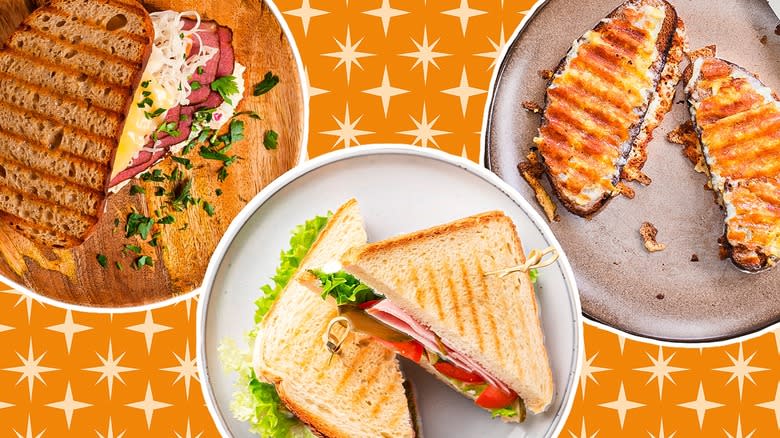
There's no shortage of intriguing, and sometimes disturbing, retro recipes from decades past. This is especially true during the years following World War II when post-war opulence popularized both comfort food and convenience products. But as it turns out, this era wasn't limited to quirky casseroles, questionable Jell-O creations, and bright fruit salads. Even sandwiches — a classic and seemingly innocent dish — fell victim to the dubious ingredient combinations and strange presentations that were trendy during the 1950s. Thankfully, many of these options have fallen out of style. Or, in some cases, evolved into something a bit more palatable.
Meanwhile, other popular 1950s sandwiches have hung around, eventually become standard options in the sandwich scene. It's a testament to the delicious nature and timelessness of each variety, considering fads and preferences naturally change over the years. In fact, there's a good chance you'll recognize some retro sandwiches as staple menu items at your favorite restaurant, diner, deli, café, or even your own kitchen.
With that in mind, if you decide to recreate any of these trendy sandwiches from the 1950s, don't hesitate to add your own flair or swap ingredients based on your dietary needs or preferences. For example, if you follow a gluten-free diet, any sandwich can be made with gluten-free bread. Many of sandwiches also contain deli meat, but you can make it meat-free by using your favorite plant-based slices.
Read more: 25 Most Popular Snacks In America Ranked Worst To Best
Frosted Sandwich Loaf
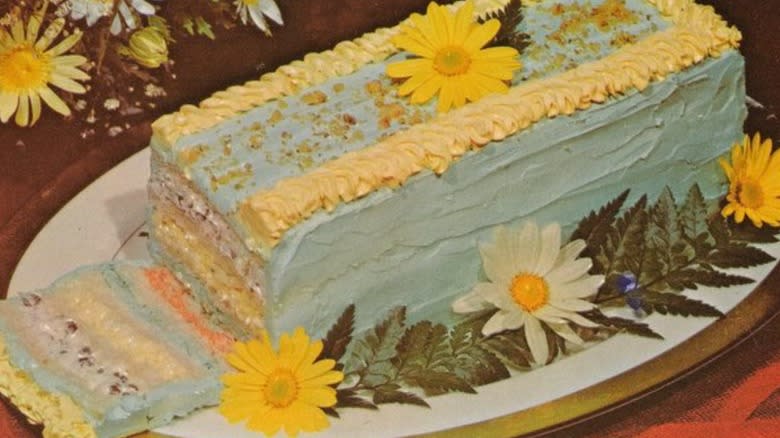
If you could travel back in time and attend a tea party in the 1950s, there's a good chance you'll find a frosted sandwich loaf, also known as a party loaf. This is a concoction that looks like a rectangular cake but actually consists of bread layered with savory fillings and coated in cream cheese.
The fillings vary by recipe, but a version found in a vintage Better Home & Gardens cookbook suggested three options: mayonnaise with crab, pimento cheese with olives, and cream cheese with watercress. The outside is then covered in two (yes, two) containers of whipped cream cheese, then decorated with fresh parsley, radishes, and olives. The result? A colorful, sliceable creation that we just can't seem to look away from.
If you want to make this funky recipe for your next soiree, you'll be glad to know that you're not limited to the rich, creamy fillings listed in Better Home & Gardens' cookbook. Try it with your go-to sandwich filling, like chicken salad, egg salad, or ham salad with hard-boiled eggs. Just be sure to decorate the loaf with savory ingredients so it doesn't look like a sweet cake—otherwise, your guests will be in for a surprise.
Welsh Rarebit
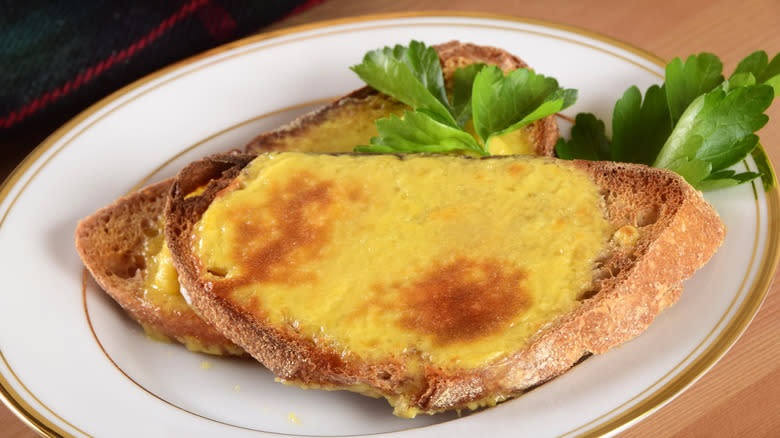
Whether an open-faced sandwich is a true sandwich is up for debate, but during the 1950s, the menu item was all the rage. In fact, open-faced sandwiches were often served at lunches as they were considered to be fancy and luxurious. One particularly beloved version was the Welsh rarebit, a simple dish that's basically a grilled cheese sandwich without the top layer of bread.
Depending on the recipe, the Welsh rarebit features what's essentially a cheese fondue sauce made of mustard, Worcestershire sauce, dark beer, hot sauce, and cheese; one 1950 recipe by Betty Crocker called for sharp cheddar cheese, though something tells us it would be amazing with Gruyère as well. The sauce is then poured on toast and enjoyed, though you can also pop it in the broiler first until the cheese becomes golden and starts to bubble.
The Welsh rarebit of yesteryear is a bit plain, however, so don't hesitate to add tasty toppings if you decide to recreate this at home. For example, topping a Welsh rarebit with caramelized onions is an excellent way to add extra flavor and texture.
Monte Cristo
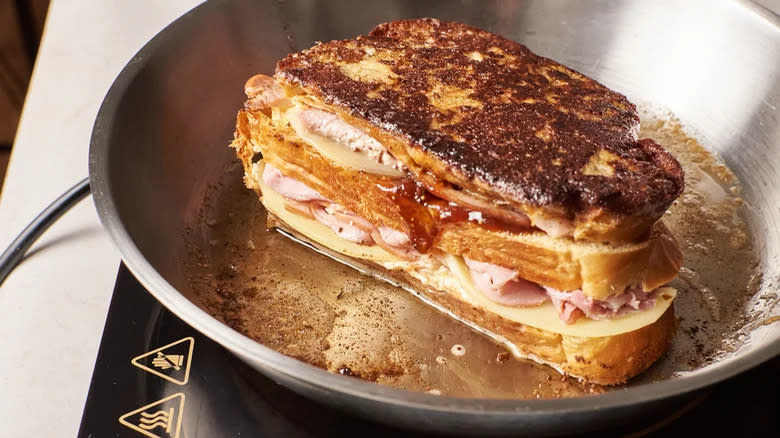
If you love the combination of sweet and savory ingredients, the Monte Cristo sandwich is the vintage sandwich for you. It's similar to the croque monsieur, a grilled cheese served in France — but unlike the croque monsieur, which is a purely savory concoction made with ham, Gruyère cheese, and béchamel sauce, the Monte Cristo also has sweet components. Specifically, it's made by layering ham, turkey, and Swiss cheese between white bread; then, the entire thing is dipped in an egg-milk batter (just like a stuffed French toast is prepared) and fried in butter until perfectly golden. The finished sandwich is then dusted with powdered sugar and served with a side of jam, preserves, or honey, which adds a complementary sweet element.
Depending on your taste buds, the sandwich might sound strange, but folks in the 1950s were all about it; the dish was served at diners and hotels all over the country. It became even more popular in the late 1960s when it appeared on the menu at Café Orleans in Disneyland. Fortunately, you don't need to go to the most magical place on earth to enjoy the magical sandwich, as the sweet-and-savory dish is still served at cafes and diners today — though you can't go wrong with a homemade Monte Cristo sandwich.
Souper Burger
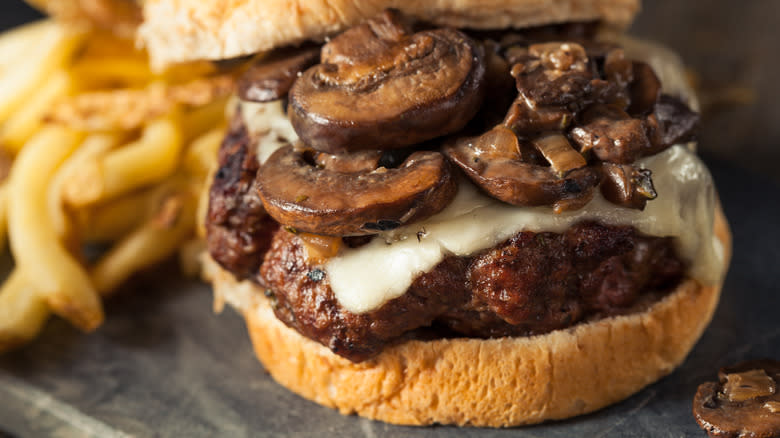
It's no secret that sandwiches and soup pair well together, but have you ever had a sandwich made with soup? Enter the souper burger, a popular 1950s sandwich created by the one and only Campbell's Soup. The exact ingredients varied by recipe, but souper burgers were essentially meat patties made of ground beef, breadcrumbs, minced onion, herbs, spices, egg, and — you guessed it — a can of Campbell's Soup.
For example, a 1957 Campbell's Soup ad featured three souper burgers made with cream of mushroom soup, gumbo soup (for "creole burgers"), and onion soup. Specifically, only ¼ cup of soup is added to the actual meat mixture, and very little seasonings were included in addition. The rest is mixed with water and poured over the top of the burgers, which are then served on toasted hamburger buns. (The ad even included a meatball version, which is made with tomato soup and served on a hot dog bun.) Although moist, the classic recipes can always do with a bit more spice.
Oyster Club Sandwich
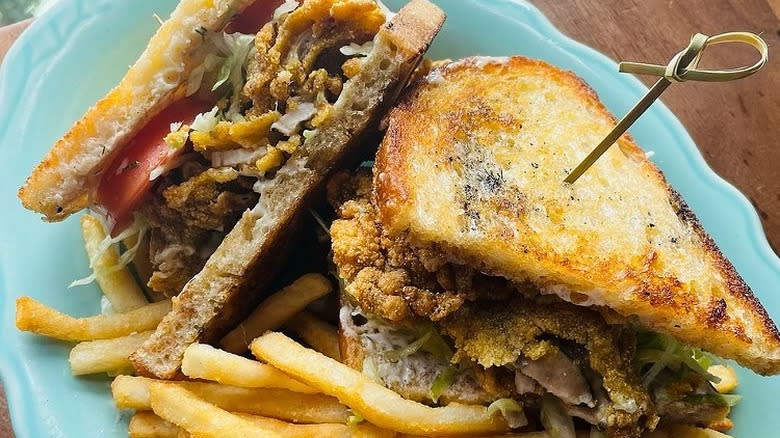
Another sandwich that was a hit during the 1950s is the oyster club sandwich, which can be considered a cross between an oyster po boy sandwich and a BLT sandwich. The filling is usually made by dunking oysters in buttermilk, then breading them in flour and frying them in bacon fat until crispy and golden. The fried oysters are then layered with strips of bacon, crispy lettuce leaves, juicy tomato slices, and creamy mayonnaise on toast, though a hard roll will likely do a better job at holding the ingredients in. In either case, it's a seafood lover's dream come true.
While you can't go wrong with the classic BLT ingredients, don't be afraid to embrace the seafood elements of the sandwich if you decide to recreate this at home. For example, lemon is delicious with seafood like oysters, so try adding zest or a splash of lemon juice to the mayonnaise to brighten things up. For a bit of umami flavor, use seaweed flakes in the flour mixture before coating the oysters. Old Bay seasoning, which is a classic partner for seafood, could also work well in the flour coating.
Reuben Sandwich
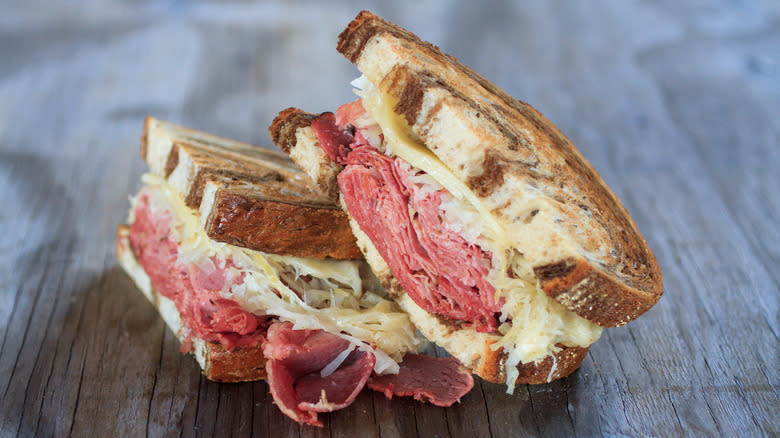
When it comes to the beloved Reuben sandwich, there are conflicting origin stories. While many a New Yorker claims it is theirs, food documentation shows that an early mention of the sandwich appears on a restaurant menu from the Blackstone Hotel in Omaha, Nebraska, where it was invented between 1920 and 1935. According to Saveur and sandwich lore, a waitress at the hotel entered the sandwich into the National Sandwich Idea Contest in 1956, and it won first place, which helped it spread to nationwide popularity.
Despite the true origin of the Reuben sandwich, one thing is for sure: It's a delicious creation. Featuring layers of corned beef, Swiss cheese, sauerkraut, and Russian dressing between slices of rye, the sandwich has a unique depth of flavor thanks to the acidic sauerkraut and molasses-infused bread. There's also a slight spicy kick from the Russian dressing, as it's made with horseradish and dill relish. The combination is clearly a winner, and you'll have no problem finding the decked-out Reuben sandwich in restaurants today.
Club Sandwich
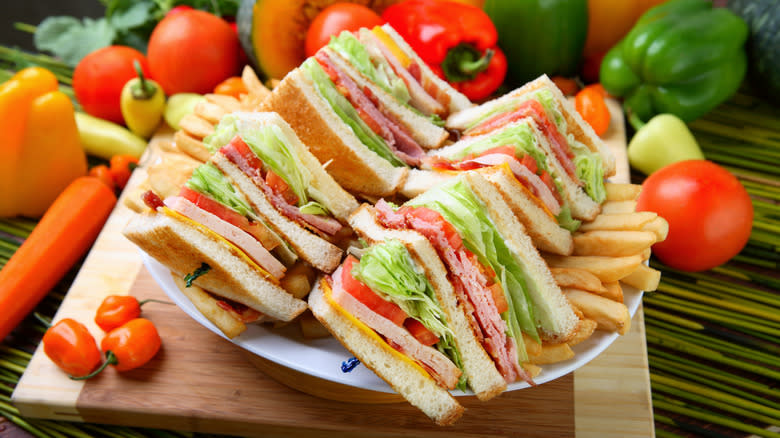
Today, the club sandwich might seem like a modest dish, but it was associated with luxury in the 1950s. It was an ode to the post-World War II era of economic growth and abundance, thanks to its triple-decker style and colorful fillings. So much so that the club sandwich was often served as fancy social clubs (thus the name "club sandwich"), whereas today, you can find different iterations of the sandwich at delis, diners, and fast-food restaurants alike.
Essentially a BLT sandwich with turkey, the club sandwich is made of turkey, bacon, lettuce leaves, tomato slices, and mayonnaise, and it's easy to recreate at home. Sliced turkey deli meat is a convenient and easy choice here, though you can also use leftover turkey from Thanksgiving for a heartier and more flavorful sandwich. If you're not a fan of turkey, you can swap it out for chicken deli meat or even rotisserie chicken for a tasty take.
Breakfast Sandwich
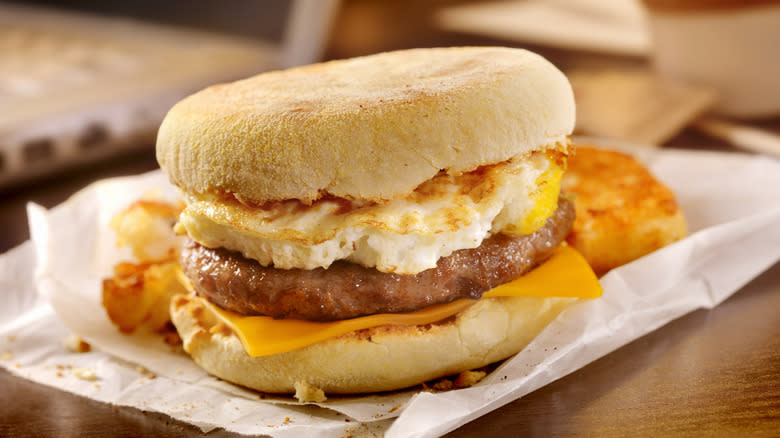
It's hard to imagine a world without breakfast sandwiches because they've been around for so long — since 1897, at least. For a while, the almighty breakfast sandwich was mainly eaten by blue-collar workers and travelers but became more popular in the 1950s after World War II, as people started to seek out more convenience food. Fast food restaurants would popularize the breakfast sandwich even more in the coming years, but we can only imagine the novelty for folks back then. A sandwich that lets you eat multiple breakfast foods in one bite? Yes, please.
The classic version consists of meat, cheese, and egg on a roll, but as any morning eater is aware, there are countless ways to upgrade the sandwich by using vegetables, spreads, and alternative bread like croissants and bagels. Needless to say, the breakfast sandwich has come a long way, and it's no wonder almost every eatery that makes sandwiches offers breakfast versions on the menu.
Friday Burgers
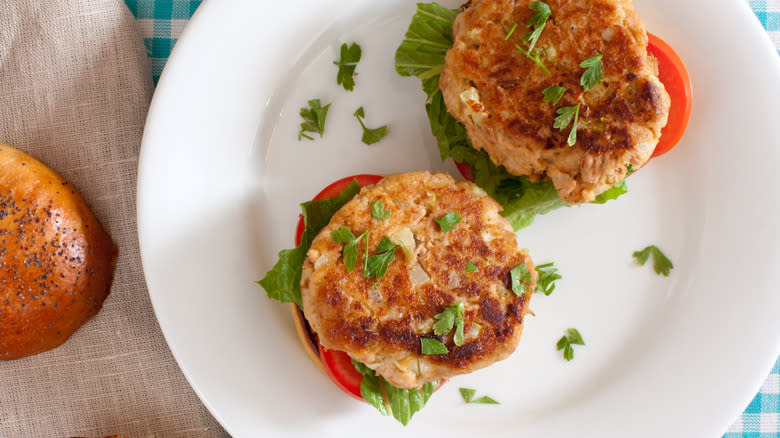
A hip sandwich during the 1950s, the Friday burger is another nod to the obsession with convenience food after World War II. It can be thought of as an early iteration of the tuna melt, as it features a baked patty made of canned tuna, Miracle Whip, breadcrumbs, onions, dill pickles, salt, pepper, and celery salt. The patty is layered with American cheese and served on toasted hamburger buns.
Today, tuna melts don't usually contain patties, but they do call for similar ingredients. The typical tuna melt is like a cross between a standard tuna salad sandwich and a classic grilled cheese, and it's wonderfully convenient to make. It starts with canned tuna, which should be drained properly to avoid a soggy and sad tuna melt sandwich. The tuna is then mixed with mayonnaise and spices (plus some hot sauce or mustard for extra flavor), layered with cheese between slices of buttered bread, then cooked until golden and crispy.
Chicken Salad Sandwich
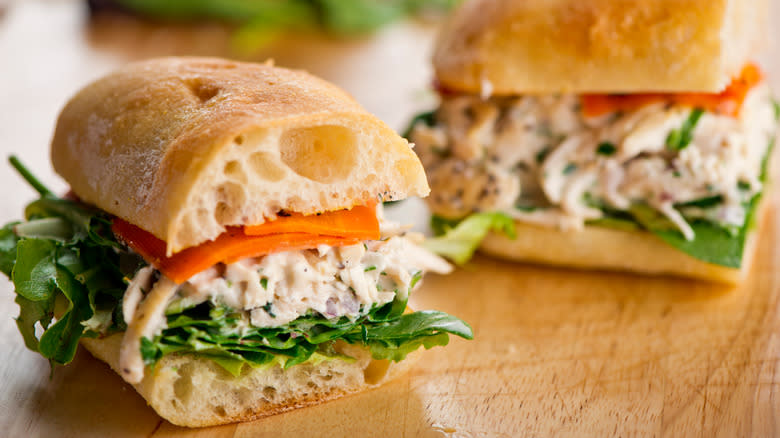
Another recipe that has stood the test of time, the chicken salad sandwich, is both simple and delicious. It's also a popular retro dish, as proven by the fact that it was served at the café at Neiman Marcus in the 1950s and maintains popularity today. According to Saveur, this particular version was created by Helen Corbitt, a Texas chef, who used cubed chicken breast, mayonnaise, sliced celery, halved grapes, toasted sliced almonds, fresh parsley, salt, ground black pepper, and — wait for it — whipped cream. The 1950s were a wild time.
Fortunately, whipped cream chicken salads are less common today. You're more likely to find the dish made with mayonnaise, mustard, salt, pepper, and maybe some diced celery for a satisfying crunch. Other options for textural add-ins include red onion, cucumbers, diced bell peppers, and nuts like chopped pecans or walnuts. Pro tip: For the best chicken salad, let the dish chill in the refrigerator overnight so the flavors can meld together.
Braunschweiburger
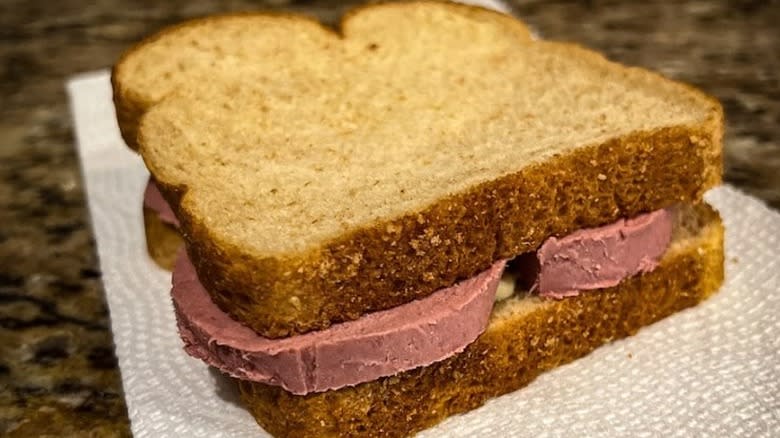
Braunschweiger is a smoked pork or beef liver sausage from Germany. It's similar to liverwurst, which is also made of pork or beef liver but isn't smoked. As the name suggests, a braunschweiburger is a sandwich made of said sausage plus ingredients like bacon, onion slices, mushroom caps, mustard, and paprika, and it was popular in the 1950s. However, as with most dishes, the exact ingredients varied slightly by recipe.
For example, in a recipe for Sky-High Braunschweiger Towers in "Sunday Night Suppers," a 1956 cookbook by the Culinary Arts Institute in Chicago, mustard is spread over slices of braunschweiger, which are then wrapped with raw bacon and secured with a toothpick. The bacon-wrapped slices are placed in a baking dish; then, each one is topped with a paprika-dusted onion slice, a tomato slice, and a buttered mushroom cap. Once baked, the "liver sausage towers" are served on toasted buns with horseradish as an open-faced sandwich.
Read the original article on Tasting Table.

